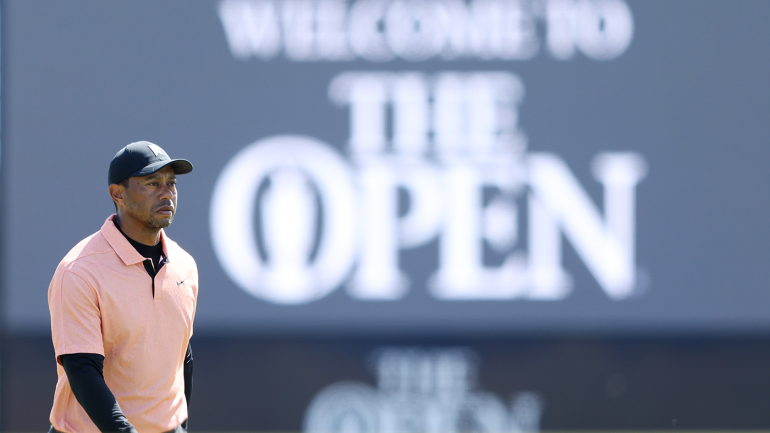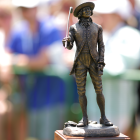
St. Andrews may have been built by the sea, but this next week -- as the golf world converges on an historic little town -- represents a crest that's building for years. The 150th Open Championship at the Old Course. What a fitting way to end the 2022 major season. Certainly, historic Opens have been held here before, but perhaps none have been quite as consequential as this one at the back end of what has been the most bizarre golf summer in decades.
Though the PGA Tour-LIV Golf battle roils on, a one-week armistice has been issued as the most famous town in golf once again unveils itself to the world. Four days at the Old Course will have to suffice for at least the next five years (the next Open Championship won't be played here until 2027 or later). It has sufficed, of course, since the American Civil War, which is almost too much history to bear in one week.
I love this fact. I feel like it really contextualizes how historic St. Andrews is.
— Sean Martin (@PGATOURSMartin) July 9, 2022
The Old Course didn't earn its moniker until St. Andrews' New Course was completed ... in 1895.
That a silver jug older than several of our states will be up for grabs at a course that's older than the United States on the same island where the Majesticks and Four Aces made their initial push to become the future of professional golf a year ago is a fact that's not lost on anyone involved.
Opens are only as important as their champions, of course, and there are some prolific potential Claret Jug hoisters in the field this week. As grand as we consider Masters, as thrilling as the PGA Championship played out, and as historically rooted as the U.S. Open is positioned, this particular Open will likely surpass those events in each category. And while it might be an overstatement to say the future of golf hangs in the balance as this Open is played, it's not much of one.
Let's take a look at the top storylines entering the 150th Open Championship.
1. Championship consequences: What do I mean when I call this Open consequential? For starters, it could be the last for some historically great Open golfers. Sergio Garcia, Lee Westwood and Ian Poulter lose their automatic qualifications in 2023 and may not be able to qualify due to their affiliation with LIV Golf, and therefore, an inability to gain points in the Official World Golf Rankings. Brooks Koepka and Dustin Johnson may not be too far behind. Depending how the next few years go, this could be the last time all the top talent in the world gathers in the same town for the same Open.
It runs deeper, though, because there is a sense the PGA Tour is where Real Professional Golfers play, while LIV Golf is for the injured, washed up or those indifferent to major trophies. However, if somebody from LIV Golf wins this Open at St. Andrews, that narrative begins to shift. It goes from a perceived hierarchy to a true tussle and could convince more golfers to abandon ship on the PGA Tour.
On the flip side, if one of the PGA Tour's fortresses wins an Open at St. Andrews it sets the tone for an offseason. Right or wrong, it would serve as a reminder that the PGA Tour is where those golfers serious about winning championships play. Whether that can stem the tide of defections remains to be seen, but the potential is there for a winner this week to truly change the arc of golf history, even if only in a small way. There aren't many majors about which you can definitively say something like that before a ball is teed off.
2. Tiger Woods' last go? There is a non-zero chance that Woods is playing his last Open at St. Andrews this week, and it's almost a certainty that this will be his last trek at St. Andrews in which he has even a shred of hope to contend. Tiger said last week that he skipped the U.S. Open because this one was too monumental to risk missing. Some have opined that he could announce his retirement from professional golf this week, and while that is unlikely, he knows that this is the last good one he'll get at the Old Course.
We could get a bent knee and a hand to the sky on the Swilcan Bridge on Friday or Sunday. That would engender all kinds of emotion: disbelief that his time as a competitive golfer on one of the great courses in the world is drawing to a close, sadness that we'll never again see prime Tiger use those magic hands on one of the sport's great Rubik's cubes, sorrow over how quickly that time slipped away.
It seemed like yesterday when it felt as if Woods' run would never end. Tiger won his first of three career grand slams at the Old Course, later saying that "St. Andrews [in 2000] was a different level of ball-striking. I hit it so much better than I did at Pebble [Beach]." A reminder: Woods won the U.S. Open at Pebble that year by 15 strokes.
It felt as if one was watching Woods walk through the pages of time itself. That's no longer the case, which is humanizing, but far more difficult to reconcile. Like any champion who knows the dark depths of what is required, he can sense the finish line of his career even if he's not totally sure if he's in front of or behind it. Regardless, he knows that in five years' time, this will be deep in the rear-view mirror; while he might play an Open at age 51 or beyond, this is his last real opportunity to pin the course he covets most.
It seemed like yesterday when it seemed like his run would never end. He won his first of three career slams at this course, and it felt as if you were watching someone walk through the pages of time itself. It no longer feels like that, which is humanizing, but far more difficult to reconcile. Like any champion who knows the dark depths of what is required, he can sense the finish line of his career even if he's not totally sure if he's in front of or behind it. Regardless, he knows that in five years it will be deep in the rear view mirror, and while he might play an Open at age 51 or beyond, this is the last time he'll have a real chance to pin the course he covets most.
3. Will Scottie Scheffler's all-time run continue? Scheffler's had a tremendous year. He's won four of the 10 best events of 2022 and collected more money this season than any golfer in the history of the PGA Tour. He won the Masters. He became the 25th man to ascent to No. 1 in the world. It's been the stuff of dreams. If he somehow bookends his green jacket with a Claret Jug, it goes from one of the great years of the last decade to one of the great years in golf history. Only four other golfers have ever won five times in a year with two of those at the Masters and The Open. And only Tiger did it at Augusta National and St. Andrews.
If Scottie Scheffler wins The Open at St. Andrews next week, he'll have won five times on the PGA Tour this year including the Masters and Open. Here are the other golfers who have done that.
— Kyle Porter (@KylePorterCBS) July 6, 2022
Ben Hogan in 1953
Arnold Palmer in 1962
Tom Watson in 1977
Tiger Woods in 2005
4. Collin Morikawa's back-to-back bid: No one has won back-to-back Opens since Padraig Harrington in 2007-08 (immediately following Tiger in 2005-06). Morikawa has yet to find the winner's circle this year after claiming six of his first 64 OWGR tournaments (9.4%). He is not the first player who comes to mind when you think about somebody battling the wind and the elements on a links course, but he obviously has the goods to win an Open (albeit a more benign one than most). Was Morikawa at Royal St. George's a "Jordan Spieth at Chambers Bay" situation where it happened once but almost certainly won't happen again? If he does come through, what are we going to do when Morikawa grabs a PGA Championship and two Opens (including St. Andrews) by age 25? Time will tell how one of the great iron players of the last 50 years can stand up to Open conditions, but his jug defense will be a massive storyline in a year when the last five major champions (including Morikawa) have been Ryder Cuppers in their 20s.
5. The buoy: Jon Rahm has been suspiciously quiet at major championships this year after finishing in the top eight across all four of the events a year ago. His closest push in 2022 is a T12 at the U.S. Open, though he completely ejected in the final round. However, he hasn't missed a cut at a major since the 2019 PGA Championship and is coming off his best Open ever last year when he finished T3 at Royal St. George's. He's dropped off from the clip he was playing at this time last year through the end of January 2022, but this is one last chance for him to remind everyone who the most consistently great player in the world has been over the last five years.
List of players to play in each of the last 12 major championships (dating back to the 2019 U.S. Open) and make every single cut:
— Phillip Allen (@PhilAllenTFG) July 6, 2022
Jon Rahm#buoy
6. Easy Old Course? This particular Open has become a vehicle for a variety hopes and future plans from myriad entities within golf. Perhaps none more prominent than the contingent that wants to roll equipment back so that places like St. Andrews are still viable major championship venues in 20-50 years.
"If someone scores 13 under for a round of golf, then good luck to them, but I don't want it to happen at St. Andrews. It wouldn't be right, somehow," Colin Montgomerie said recently. "If it's calm and the pins aren't hidden too much, and they will have to tuck them away, and you can get to pins with wedges, then I fear for it and I don't want to. It doesn't deserve to have a 59 on it."
That's the big-picture story, but on a more micro level, this Open could produce some silly numbers if the wind fails to howl. That's one of the risks of going to places like St. Andrews, and it would be such a massive bummer for one of this week's narratives to become what, coincidentally, one of the biggest narratives of the last month has been: That the sport that's being played is not what golf is supposed to be.
Average winning score in The Open since 1990: -9.8
— No Laying Up (@NoLayingUp) July 9, 2022
Average winning score at St. Andrews since 1990: -14.6
5 of the 10 lowest winning scorers in The Open in that timeframe are at St. Andrews.
Scores will almost certainly be low next week.
Average winning score in The Open since 1990: -9.8
— No Laying Up (@NoLayingUp) July 9, 2022
Average winning score at St. Andrews since 1990: -14.6
5 of the 10 lowest winning scorers in The Open in that timeframe are at St. Andrews.
Scores will almost certainly be low next week.
7. Spieth's return: The last time Spieth played the Old Course, he took the grand slam to the 215th major hole of the year. He made a five at the Road Hole and butchered the last to finish one stroke out of a playoff. Still, he has blistered Opens since then with just one finish outside the top 20 and three top 10s including a victory in 2017 at Royal Birkdale. Though Spieth has contended at majors since that 2017 win at Birkdale, he's starting to get into a bit of "Rory McIlroy hasn't won a major since 2014" territory himself.
The last time The Open came to St. Andrews, those two had possession of every major championship. Since then, they have one combined major victory (one fewer than Woods and Phil Mickelson). A win at the Old Lady to go with his U.S. Open, his other Open and a single green jacket would reignite the conversation about Spieth being a generational player.
"I think The Open at St. Andrews is arguably the best golf tournament we play," said Spieth recently. "… Maybe it's just I remember watching certain ones growing up, and so the holes, the kind of scenic holes starting and finishing, [I] really kind of hold onto. Then it was a really special tournament for me back in 2015 trying to go for a third in a row and just kind of the crowd, you know, the putt I made on 16 and kind of the finish, it was really fun contending in that major and having a chance to win."
8. Another blowout? One unadvertised bit about the last four Opens at St. Andrews? Three of them have been blowouts. Tiger trounced Thomas Bjorn and Ernie Els by eight in 2000. Then he beat Colin Montgomerie by five in 2005. Louis Oosthuizen got Lee Westwood by seven in 2010. Finally, there was a playoff between Oosthuizen, Zach Johnson and Marc Leishman in 2015. The reason for this is likely that the Old Course rewards great shots more disproportionately than a lot of other tracks, which means you can create separation if you're truly on point. This is often the indication of a terrific golf course, but the flip side is that it doesn't make for compelling theater on the weekend.
9. The proper side of the draw: How many of the 149 prior Open Championships have been decided by tee times? Because the R&A eschews a shotgun start, unlike some other tournaments, the North Sea has probably selected more Open champions than any of the DFS podcasts you follow (including ours). The forecast looks mostly benign (for now), but last time out at St. Andrews, The Open went to a Monday finish because the wind was so strong that balls were rolling around even on the slow greens of the Old Course. Koepka nearly had a conniption over being forced to play. Spieth summed it up best recently when he was asked about the Old: "The history of it, playing in the town, the idea that it could be the easiest or the hardest venue that we play depending on the day."
10. Rory McIlroy's time? The epicenter of this Open. The eye of its storm. McIlroy has been the fulcrum upon which golf has hinged for months. He has been the most vocal ambassador for what the sport should look like. He has been golf's wisest voice. He has also (as always) been the adult in the room. This doesn't mean McIlroy's been perfect, nor does it mean he's without fault, but Rory has been an ambassador for those who still believe golf's championships are meaningful.
It would be the perfect ending to the summer if the player who has stood at the front of the line to fight for the future of golf was rewarded with a championship that has eluded him for nearly a decade. The only player who deserves a major is the one who plays the best in any given week, but there would be a lot of folks in a lot of corners of the golf world who would enjoy seeing this happen. Consider The Open's mantra for this 150th edition of its grand old tournament at the Auld Grey Toon: "Everything has led to this." You could say the same about golf's most important star.
If Rory wins at the Old Course, golf is the most romantic sport ever.
— Sean Zak (@Sean_Zak) June 23, 2022
If he finishes T2 with a double on Sunday, I will walk into the North Sea and never return.
11. English drought: Though the United Kingdom has technically brought home multiple Opens since the turn of the century, nobody from Scotland has won this century, the last being Paul Lawrie in 1999. An English golfer has not won since Nick Faldo in 1992. This is an extraordinary drought for two of the proudest golf nations in the world. While Scotland's drought is likely destined to continue (apologies to Robert MacIntyre), Matt Fitzpatrick and his newfound speed have a real chance to pull off the first U.S. Open-Open Championship double since Woods in 2000 ... at St. Andrews. Since World War II, only Ben Hogan (1953), Lee Trevino (1972), Tom Watson (1982) and Woods (2000) have won both the U.S. Open and the Open Championship in the same year.
12. First at Firth of Forth: Two of the three major winners this year have been first-timers, which was also true a year ago entering The Open. The contingent of good players to have never won a major championship simultaneously grows and shrinks, but the golfers who stand out now are Xander Schauffele (entering hotter than anyone in the world), Patrick Cantlay (major performances incongruent with overall skill level), Viktor Hovland (fallen off pace of the best players in the world) and Sam Burns (least-heralded 25-year-old American top 10 player perhaps ever). Any of them grabbing major No. 1 this week at St. Andrews would completely recalibrate our perception of their trajectory and their expectations of themselves. To see a player win his first major is always a delight. To see it at the 150th Open at St. Andrews would be completely overwhelming.





















